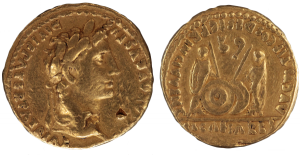
October 13, 2017, by Helen Lovatt
The old pound coin goes out of circulation on Sunday – but what did the Romans do with old coinage?
A post by Notitngham PhD student Becky Batty, guest from Mint Imperials
[English pound coin, 2008 – one for the archives!]
If you’ve been in the UK over the past couple of months, you’re sure to have noticed the gradual disappearance of the ‘old’ pound. The new 12-sided pound coins have been slowly replacing the old round coin, which goes out of circulation this Sunday 16th – causing upheaval for lockers, trolleys, and really old drinks machines everywhere.
But what did the Romans do when they wanted to introduce new coins? New coins would be introduced into circulation at the start of a new emperor’s reign, alongside the old currency. At the start of the Roman empire, coins had a fairly high intrinsic value based on their material.
The introduction of new coins, with lower intrinsic values, surprisingly appeared to make no difference up to the reign of Septimius – so an older coin might have a higher silver content, but still be worth the same as a newer coin with less silver.[i]
After Septimius, silver coins went into rapid decline, and became subject to melting down or hoarding. So if you’ve still got a pile of old pound coins after Sunday, you can do as the Romans did and bury them in the ground to confuse future archaeologists.
On rare occasions, coins could be recalled and melted down en masse after a particularly hated emperor – Dio tells us Caligula’s bronze coins were melted down because they had his face on.[ii]
Like us, Roman currency often suffered from forgeries and devaluation, causing problems in the economy. However, due to the sheer size and distance of the Roman empire, a complete recall was impossible, and dealing with fakes difficult. We still have some fake coins made in ancient times!
The proliferation of forgeries led to people checking the content of the coins by hand to approve their worth. For example, in the coin below, we can see a small triangle just under Augustus’ chin. This is where someone has stamped to check that the whole coin was gold, rather than just gold plated. It’s almost like holding an old pound coin to check its weight, or like putting an old £20 note under a UV light.
[2 AU aureus of Augustus. Ob. has laureate head of emperor right, [CA]ESAR AVGVSVS DIVI F PATER PATRIAE.]
With the introduction of the new currency in the UK, actions like these should be made obsolete – hopefully we won’t have to be burying currency any time soon!
[i] Estriot, Slyviane, ‘The Later Third Century’, in Oxford Handbook of Greek and Roman coinage, ed. Metcalf, E (ed.), 2012, pp 539-560, p 540.
[ii] Cassius Dio, Roman History: 60.22



Were there no (partial) recalls or incentives to return old coins of better alloy? This seems likely at the time of Nero’s monetary reform (I think it’s more a reform than just a debasement of the coinage) since the pre-64 silver coinage is now quite scarce. Or else perhaps it was expected that the payment of taxes would be sufficient to cause a rather swift withdrawal of older coins from circulation (?). A better example, though, is the “restitution issues” of Trajan, who basically took out of circulation what remained of Republican coinage (yes – very worn but some of it still circulating) and, to make amends, issued the new coins (on a lower standard of course) with the same Republican types, hence “restitution” issues.
Oh! I should add that Mark Antony’s “legionary denarii” remained in circulation for a very long time (and the proportion of very worn such coins is very high now) precisely because people were aware that they had been struck on a lower standard than the rest of the Roman silver coinage. Other coins, therefore, disappeared more quickly from circulation though, as I said, some Republican coins remained in circulation as late as Trajan.
Hi Guy – thanks for reading and responding.
In answer to your question, from what I can tell there seems to have been no particular incentives offered to return old coinage, at least for Nero’s change in the coinage. I think, as you say, that the payment of taxes gave the opportunity for recycling the coins, rather than a concentrated effort to remove and replace older coinage. Hoard evidence from the Flavian period suggests that Republican coins were still present alongside newer Neronian coinage – as you’ve also pointed out! I suppose that as long as the value of the denomination was higher than the intrinsic value of the coin, there would be no real reason for people to not use older, but more materially valuable coins, alongside newer ones. This would allow gradual replacement without a complete recall.
In terms of Trajan’s recall, Kevin Butcher and Matthew Ponting have an interesting article on Trajan’s reforms, which argues that his change of coinage actually reflects a change in source – the mineral content doesn’t reflect the mineral content of previously recycled Republican coins. This suggests another motive for recalling older coinage, rather than just for its material. You can find the open access article here: http://wrap.warwick.ac.uk/83712/1/WRAP_classics-071116-02butcher_rev..pdf
Hi Becky, Thanks for the reply.
I will be interested in looking at the article you mention. The link is broken, but I suppose this is it: https://www2.warwick.ac.uk/fac/arts/classics/staff/butcher/butcher.ponting_aiin.pdf
Guy